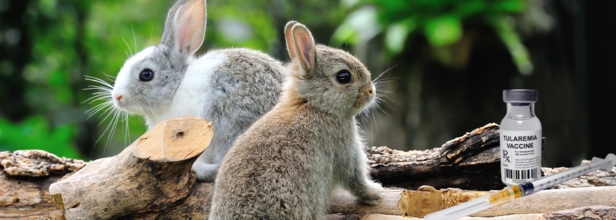- Health Conditions A-Z
- Health & Wellness
- Nutrition
- Fitness
- Health News
- Ayurveda
- Videos
- Medicine A-Z
- Parenting
Rabbit Fever In US, What Is It All About?

Credits: Canva
As per the US Centers for Disease Control and Prevention (CDC), case numbers of infectious disease tularemia, or 'rabbit fever' have surged in the United States over the past decade. The disease is on rise.
The Name and origin
As per a 2014 study in the Balkan Medical Journal, Tularemia was first described as a disease of the rodent group called lemmings in the 16th century in Norway. It was also later described in Japan and Russia in the 1800s. The infectious agent was found from dead ground squirrels in 1911 in Tulare, California. This is where it derives its name from. Due to the region of its discovery, it was known as the Bacterium tularense.
The first human cases were reported by Lamb and Wherry in 1914. Edward Francis was the first one to study the epidemiology of the disease in humans. He said that many people with different "clinical presentations" suffered from the same disease. It was found to be transmitted through contact with the infected meat of rabbits and rodents. "Serological tests were devised for the diagnosis, and a vector role of blood-sucking flies was established," reads the study.
How can humans get infected?
Humans can contact this disease through bites from infected ticks and deer flies, and direct skin contact with infected animals such as rabbits, hares, and rodents. There are other methods of transmission, including mowing over nests of infected animals which can aerosolize the bacteria and infect the person operating the mower. This mode of transmission was first observed in 2000 at a Massachusetts vineyard, where the Tularemia outbreak persisted for 6 months. This resulted in 15 confirmed cases and one death. In fact, one of the several cases reported in Colorado during 2014-25 was also linked with lawn mowing.
As per the CDC, the bacteria is not only classified Tier 1 Select Agent, but it can have the potential to use in bioterrorism. This is when transmitted, without proper treatment, it can be lethal. The CDC report notes: "The case fatality rate of tularemia is typically below 2%, though it can be higher depending on the clinical presentation and bacterial strain."
What are the types of Tularemia?
The F. tularensis (where the F stands for Francis, from Edward Francis, who was the first one to study the epidemiology of the disease in humans), gets into your body and are "eaten" by cells of your immune system. These cells then would usually destroy the bacteria, but instead, the bacteria multiply inside the body. The bacteria destroy the immune cell and infect other cells too.
There are 6 types of Tularemia that can affect your body:
Ulceroglandular Tularemia: This is the most common one that you can get from being bitten by tick or infected animal. This affects your skin and lymph node.
Glandular tularemia: Similar to ulceroglandular tularemia, but it only affects your lymph nodes. You get glandular tularemia from a tick bite or directly from an infected animal.
Oculoglandular tularemia: This happens if you get contaminated water or body fluids in your eyes.
Oropharyngeal tularemia: This happens through contaminated food and can cause a sore throat or digestive symptoms.
Pneumonic tularemia: This can be caused by F tularensis spreading in your lungs from somewhere else in your body, causing you symptoms similar to pneumonia.
Typhodial tularemia: This causes a high fever and affects many parts of your body. You can get typhoidal tularemia the same way as other forms of tularemia.
Symptoms
While symptoms differ on the basis of gravity and the kind of tularemia, here are some common symptoms:
- High Fever
- Open would or ulcer on your skin
- Large, painful, lymph nodes
- Watery eyes
- Sore throat
- Cough
- Muscle aches
- Loss of appetite
- Vomiting or diarrhea
Ozempic Launches In India At Rs 2,200 For Starter Dose: All You Need To Know

Credits: Canva
Danish drugmaker Novo Nordisk has officially introduced its widely known diabetes medication Ozempic in India, pricing the starter dose of 0.25 mg at ₹2,200 per week. According to a Reuters report, the injectable medicine will be available in three strengths in the country: 0.25 mg, 0.5 mg and 1 mg.
Ozempic is a once-weekly injectable prescribed for people living with type 2 diabetes.
Ozempic Price In India
The weekly injection received approval from the US Food and Drug Administration in 2017 for treating type 2 diabetes. Since then, it has grown into a global blockbuster and is also commonly prescribed off-label for weight loss because of its appetite-suppressing effects.
The lowest strength will cost ₹2,200 per week. Prices for the higher doses have also been announced, as per the Reuters report.
Here are the details:
- 1 mg dose: ₹11,175/month
- 0.5 mg dose: ₹10,170/month
- 0.25 mg dose: ₹8,800/month
All you need To know About Ozempic
India’s drug regulator, the Central Drugs Standard Control Organisation (CDSCO), approved Ozempic, also known as semaglutide, in October this year for adults with type 2 diabetes.
As per the US FDA, Ozempic is prescribed along with diet and exercise to improve blood sugar control in adults with type 2 diabetes mellitus. It is also indicated to reduce the risk of major cardiovascular events in adults with type 2 diabetes who already have heart disease.
As per NDTV Profit, currently, Wegovy is priced at Rs 2,712 per week for the 0.25 mg dose, while the 0.5 mg dose costs Rs 3,462 weekly. The 1 mg dose is also priced at Rs 3,462 per week, and the 1.7 mg dose is available at Rs 4,100 per week. Mounjaro (tirzepatide), a combination therapy of GLP-1 receptor agonist and GIP that helps improve blood sugar control in adults with type 2 diabetes when paired with a healthy diet and regular exercise, is priced at Rs 13,500 per month for the 2.5 mg dose.
How Does Ozempic Help In Weight Loss?
Ozempic mimics the action of a naturally occurring hormone called GLP-1. Here’s how it supports weight loss, as outlined in an earlier HT report.
- It boosts insulin release when blood sugar levels increase.
- It slows down the emptying of food from the stomach, helping people feel full for longer after meals.
- At higher doses, it can also curb appetite, which may aid weight management efforts.
Possible Side-Effects Of Ozempic
As previously reported by Mayo Clinic, some potential side-effects of Ozempic include:
- An increased risk of inflammation of the pancreas.
- Possible gallbladder-related problems.
- According to the FDA, the most commonly reported side effects, seen in at least 5 per cent of patients taking Ozempic, include nausea, vomiting, diarrhoea, abdominal pain and constipation.
This article is intended for informational purposes only and should not be taken as a replacement for professional medical advice.
Delhi Air Quality Hits ‘Severe,’ GRAP-3 Curbs Kick In: Full List Of Restrictions Explained

Credits: Canva
Anti-pollution measures under GRAP-3 came into force in Delhi on Saturday as air quality slipped into the “severe” bracket. By noon, the national capital reported an Air Quality Index of 405, according to figures released by the Central Pollution Control Board (CPCB). Earlier in the day, Delhi’s AQI hovered close to 390 during the morning hours.
Delhi Air Quality Hits ‘Severe'
Each winter, Delhi and the surrounding NCR (National Capital Region) bring in curbs under the Graded Response Action Plan, which divides air quality into four levels: Stage 1 (Poor, AQI 201–300), Stage 2 (Very Poor, AQI 301–400), Stage 3 (Severe, AQI 401–450) and Stage 4 (Severe Plus, AQI above 450).
Under GRAP-3, non-essential construction and demolition activities have been halted, along with stone crushing and mining operations. The measures also include restrictions on older diesel goods vehicles within Delhi. Schools up to Class 5 are required to move to a hybrid learning model, while offices across Delhi-NCR may function with only 50 per cent staff strength, as per Press Information Bureau.
Hazardous AQI levels have become a recurring feature across several parts of Delhi during the winter months. Quoting environmental experts, an IANS report linked the sharp decline in air quality to a mix of stagnant wind conditions, vehicle emissions, industrial pollution and seasonal factors such as crop residue burning in neighbouring states.
What Changed in GRAP?
The biggest shift under the updated GRAP framework is that stricter steps will now come into force earlier, instead of waiting for air quality to deteriorate further.
As per Press Information Bureau, under the revised system, measures that were earlier reserved for Stage 4 will now apply at Stage 3 itself. This means that once the AQI reaches the 301–400 range, public, municipal and private offices will function with only 50 percent staff. Central government offices will also move to work-from-home at this stage, rather than waiting for the AQI to cross 450.
In the same way, actions that earlier fell under Stage 3 have now been pushed to Stage 2. As a result, staggered timings for government offices will begin as soon as the AQI enters the 201–300 category.
Stage 2 measures have also been advanced to Stage 1. This brings uninterrupted power supply arrangements into effect earlier, at an AQI level of 101–200, to reduce the need for diesel generator use and limit additional emissions.
Delhi AQI: GRAP Stage 3 Restrictions Announced
In response to the worsening situation, the Delhi government confirmed that the Commission for Air Quality Management (CAQM) has activated all measures under Stage III of GRAP, which falls under the “Severe” air quality category with AQI levels between 401 and 450, across the entire NCR.
These Stage 3 curbs will apply in addition to the existing Stage I and Stage II measures. Authorities, including NCR Pollution Control Boards, have been instructed to step up enforcement to prevent further deterioration of air quality across the region.
- Ban on the transportation of construction materials such as sand and cement, particularly on non-paved roads
- Complete suspension of demolition and construction work unless unavoidable, including earthwork, piling and trenching
- Advisory for private firms to permit work-from-home or hybrid arrangements to reduce traffic-related pollution
- Restrictions on inter-state diesel buses entering or operating within Delhi
- Prohibition on BS-3 petrol and BS-4 diesel four-wheelers in Delhi and nearby NCR districts
- Shutdown of stone crushers, mining operations and hot-mix plants that do not run on clean fuel
- Ban on the use of diesel generator sets, except for emergency and essential services
GRAP III Imposed in Delhi-NCR: What’s Allowed
Even as Stage III of the Graded Response Action Plan comes into force, certain essential activities and services will continue to operate to minimise disruption to daily life.
- Essential infrastructure and public service projects permitted include:
- Metro, railway, airport, highway, defence, healthcare and sanitation-related projects
- Construction work linked to critical infrastructure, provided strict dust control and proper waste management norms are followed
- Vehicles used by persons with disabilities
- Recommended measures under GRAP III include:
- Greater use of public transport to reduce private vehicle emissions
- Hybrid or online classes for students up to Grade 5 to limit outdoor exposure and traffic movement
US FDA Approves First At-Home Device To Treat Depression – Here’s What You Need To Know

The U.S. Food and Drug Administration has cleared an at-home brain stimulation headset developed by Flow Neuroscience to help treat depression, giving patients another option beyond standard antidepressant drugs, which many people struggle to stay on because of long-term side effects, the company announced on Thursday.
Rates of depression in the U.S. have climbed sharply, rising by about 60% over the past ten years and now affecting more than 20 million adults, according to data from the Centers for Disease Control and Prevention.
FDA Approves First At-Home Brain Stimulation Device For Treatment of Depression
The US Food and Drug Administration (FDA) has approved a home-use brain stimulation device designed to treat major depressive disorder in adults. The device, known as FL-100 and made by Flow Neuroscience, is the first at-home treatment of its kind to receive approval in the United States.
The FDA’s decision was supported by results from the Empower phase 2 clinical trial, which found that 58% of participants reached remission after 10 weeks of treatment. Flow Neuroscience also reported that among users worldwide, 77% noticed an improvement in symptoms within three weeks. To date, more than 55,000 patients have used the device in regions including Europe, the UK, Switzerland, and Hong Kong.
Brain Stimulation Device For Depression: How Will The Headset Work?
The prescription device, called FL-100, uses transcranial direct current stimulation to send a mild electrical current to the brain’s prefrontal cortex, an area involved in mood control and stress response. According to Flow, this part of the brain is often less active in people living with depression, a condition that affects over 20 million adults across the U.S.
Flow noted that roughly one in three people with depression does not respond adequately to antidepressant medications, and many others discontinue them because of unwanted side effects.
“Flow’s FDA approval marks a turning point in depression care, representing the first real move away from medication-only treatment toward technology-based therapies with fewer side effects,” said Flow CEO Erin Lee in a statement.
During the study, participants wore the headset for 30 minutes per session while resting, beginning with five sessions a week for the first three weeks, then reducing to three sessions per week for the rest of the trial. The program also included live remote monitoring through video calls.
Researchers observed benefits in patients who were already taking antidepressants for treatment-resistant depression or receiving psychotherapy, as well as in those who were not using medication at all.
“Among people using Flow in real-world settings, 77% report feeling better in as little as three weeks,” said Kultar Garcha, M.D., chief medical officer at Flow. “A treatment that was once limited to clinics can now be used at home, offering a practical way to widen access to effective depression care.”
Flow said it plans to launch the headset commercially in the U.S. in the second quarter of next year and intends to explore its potential use for conditions such as traumatic brain injury, addiction, and sleep disorders.
“We want Flow to become part of the standard pathway for treating depression,” Lee said. “Our focus is clear: to help as many people as possible reach remission and regain their quality of life.”
© 2024 Bennett, Coleman & Company Limited

